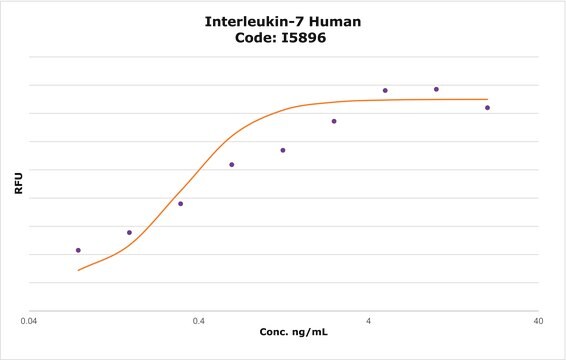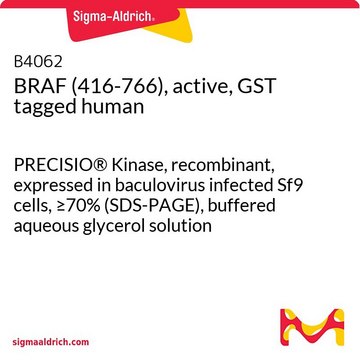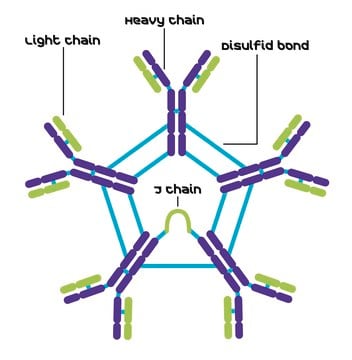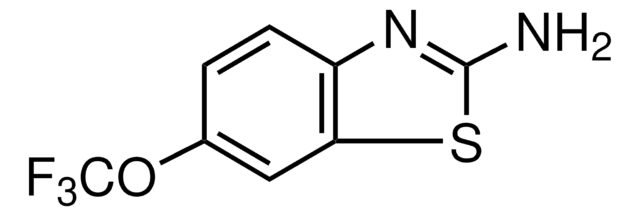Alle Fotos(1)
Wichtige Dokumente
I5528
Interferon-Inducible T Cell α Chemoattractant human
≥97% (SDS-PAGE), recombinant, expressed in E. coli, lyophilized powder, suitable for cell culture
Synonym(e):
β-R1, H174, I-TAC, SCYB9B
Anmeldenzur Ansicht organisationsspezifischer und vertraglich vereinbarter Preise
Alle Fotos(1)
About This Item
Empfohlene Produkte
Biologische Quelle
human
Qualitätsniveau
Rekombinant
expressed in E. coli
Assay
≥97% (SDS-PAGE)
Form
lyophilized powder
Wirksamkeit
10-20 ng/mL ED50
Mol-Gew.
8.3 kDa
Verpackung
pkg of 25 μg
Methode(n)
cell culture | mammalian: suitable
Verunreinigungen
<0.1ng/mg
UniProt-Hinterlegungsnummer
Lagertemp.
−20°C
Angaben zum Gen
human ... CXCL11(6373)
Biochem./physiol. Wirkung
I-TAC (Interferon-inducible T-cell α chemoattractant) is a chemokine which participates in recruitment of inflammatory cell. It binds to receptor CXCR3 (C-X-C motif chemokine receptor 3). I-TAC is associated with the severity of dengue.
Physikalische Form
Lyophilized in 30% acetonitrile and 0.1% trifluoroacetic acid containing 1.25 mg of bovine serum albumin.
Hinweis zur Analyse
The biological activity is measured by its ability to induce chemotaxis in IL-2 cultured human lymphocytes.
Lagerklassenschlüssel
11 - Combustible Solids
WGK
WGK 3
Flammpunkt (°F)
Not applicable
Flammpunkt (°C)
Not applicable
Hier finden Sie alle aktuellen Versionen:
Besitzen Sie dieses Produkt bereits?
In der Dokumentenbibliothek finden Sie die Dokumentation zu den Produkten, die Sie kürzlich erworben haben.
B P Hoh et al.
Human immunology, 76(6), 421-426 (2015-04-11)
Dengue causes significantly more human disease than any other arboviruses. It causes a spectrum of illness, ranging from mild self-limited fever, to severe and fatal dengue hemorrhagic fever, as evidenced by vascular leakage and multifactorial hemostatic abnormalities. There is no
D P Widney et al.
Journal of immunology (Baltimore, Md. : 1950), 164(12), 6322-6331 (2000-06-08)
A new murine chemokine was identified in a search for glucocorticoid-attenuated response genes induced in the lung during endotoxemia. The first 73 residues of the predicted mature peptide are 71% identical and 93% similar to human CXCL11/IFN-inducible T cell alpha
M R Rani et al.
The Journal of biological chemistry, 271(37), 22878-22884 (1996-09-13)
We report preliminary characterization of a gene designated beta-R1, which is selectively expressed in response to interferon beta (IFN-beta) compared with IFN-alpha. In human astrocytoma cells, beta-R1 was induced to an equivalent extent by 10 IU/mL IFN-beta or 2500 IU/mL
Y Luo et al.
Journal of neurovirology, 4(6), 575-585 (1999-03-05)
H174 is a new member of the CXC-chemokine family. A cDNA probe containing the entire H174 coding region recognized a predominant inducible transcript of approximately 1.5 kb expressed in interferon (IFN) activated astrocytoma and monocytic cell lines. H174 message can
R Krishnan Kutty et al.
Cytokine, 74(2), 335-338 (2015-04-22)
Dysfunction of the retinal pigment epithelium (RPE) resulting from chronic inflammation is implicated in the pathogenesis of age-related macular degeneration (AMD). RPE cells adjacent to drusen deposits in the AMD eye are known to contain CXCL11, a chemokine involved in
Unser Team von Wissenschaftlern verfügt über Erfahrung in allen Forschungsbereichen einschließlich Life Science, Materialwissenschaften, chemischer Synthese, Chromatographie, Analytik und vielen mehr..
Setzen Sie sich mit dem technischen Dienst in Verbindung.








